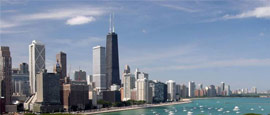The bronze lions guarding the main entrance of the spectacular Art Institute of Chicago have become true symbols of the city. This world-class museum is packed with examples of over 5,000 years of human artistry from all over the world. Of particular interest are the collections of African, Ancient American and 'modern' American art from the 17th century to the present, including two icons of 20th century American art: American Gothic (1930) and Nighthawks (1942). The beautiful building is also the capital of the French Impressionism in the American Midwest. Its collection includes one of the four surviving Water Lilies paintings by Monet, as well as work by Mary Cassatt, the only American to be included in the French Impressionist Movement.
Things to see in Chicago
Tourist offices
Address: Macy's, 111 N State Street, Loop, Chicago, Cook County, IL, 60602, United States
Tel: +1 312 781 4483.
Opening Hours:
Mon-Sat 1000-2100, Sun 1100-1900
www.choosechicago.comThe Chicago Office of Tourism, located inside Macy’s department store in the downtown Loop district, provides free brochures and a mountain of maps, plus the knowledgeable staff know all the best places to eat, sleep and visit.
CityPass (www.citypass.com) offers free admission to six Chicago attractions. It lasts for nine days and can be purchased from the attractions on the day or online in advance. GoChicago Card (tel: +1 800 887 9103; www.gochicagocard.com) offers a one to multi-day card for free admissions to over 25 attractions, plus shopping, restaurant and lodging discounts.
Millennium Park is a collage of exceptional art and architecture. The 10-hectare (25-acre) recreational area features Frank Gehry's BP Bridge and the towering stainless steel ribbons of the Jay Pritzker Pavilion, an outdoor concert venue. A video of faces are displayed on the Crown Fountain, two 15m-tall (50ft) towering glass fountains by Jaume Plensa. The stainless steel, elliptical Cloud Gate by Anish Kapoor (referred to as 'the Bean') reflects fish-eye panoramas of the skyline. Grassy and lush, the Lurie Garden pays tribute to the city's transformation from marshy flat to a beautiful metropolis.
In the 1890s, Grant Park was a marshy expanse earmarked for development, until it was saved by the wealthy Montgomery Ward and transformed by the landscaping plans of the Olmstead Brothers. The 319-acre park encompasses Millennium Park, several important museums, and two lakefront marinas. Its popular landmark, the Buckingham Fountain, is modelled after a fountain at Versailles and is a fine example of Beaux Arts landscape design. Between 1 May and 1 October, a brightly-coloured, illuminated water performance takes place from dusk until 2300.
Not quite as tall as the Willis Tower, the John Hancock Observatory is still very high at 344m (1,127ft). It is usually less crowded and gives a more scenic view of the city's shoreline. There is an excellent observation gallery on the 94th floor, which also has the outside Skywalk. One floor up is the Signature Room, a good spot to sip a cocktail while enjoying the sunset views to the west and the panorama of Lake Michigan to the east. Architecturally, the building is striking because of its massive X-shaped cross-braces.
Built in 1916, this 800m-long (2,400ft) pier was once the city's municipal wharf. After an extensive refurbishment, it encompasses parkland, gardens, piers, shops and restaurants. It also has an amphitheatre, a 50m-high (150ft) Ferris wheel and a carousel. Inside, there’s an IMAX film theatre, the Smith Museum of Stained Glass Windows, Chicago Shakespeare Theatre, miniature golf and The Chicago Children's Museum, where interactive exhibits instruct and entertain.
Formerly known as Sears Tower, this famous 110-floor city landmark stands 443m (1,454ft) high. When the day is cloudless, the views reach to Michigan, Wisconsin and Indiana up to 80km (50 miles) away. Although a working office building, there are various visitor attractions including The Skydeck, a multimedia experience showcasing Chicago's history, music, literature and sport and The Ledge, a five-sided glass box, which juts out from the tower and allows visitors to experience being suspended more than 400m (1,300ft) above the ground.
Opened in 1930, the Adler Planetarium was the Western Hemisphere's first public museum devoted to the stars. It still maintains the traditional in-the-round Zeiss planetarium (Sky Theater) as well as the state-of-the-art interactive Sky Rider where, with the help of armrest controls, visitors can choose how they would like to journey into space. Other interactive exhibits include 3-D computer animations of the birth of the solar system and of the Milky Way.
Home to 65 million year-old 'Sue', the nearest to a complete Tyrannosaurus Rex that has ever been discovered, the Field Museum explores the world's diverse environments and cultures through themed halls like Africa, Ancient Egypt and Ancient Americas. Shrinking to the size of a bug and burrowing into the surface of the soil at the Underground Adventure is among its many highlights.
Designed by Daniel Burnham for the World's Columbian Exposition in 1892, this museum charms both kids and science buffs. Ride through the coal mine, explore the WWII German submarine, the U-505, walk through the 6m (20ft) human heart or try to catch some fairy dust at Colleen Moore's Fairy Castle. Families especially enjoy the hands-on Imagination Station and the acoustically perfect Whispering Gallery.
Enter to the sound of tinkling bells, then look toward the ceiling and see Above and Beyond: 58,000 imprinted dog tags of the men and women who lost their lives in the Vietnam War. This museum is dedicated to collecting, preserving and displaying artwork done by war veterans. These powerful works give visitors a more intimate look at, and a better understanding of, the physical and emotional impact of combat.
Do you have any Feedback about this page?
© 2025 Columbus Travel Media Ltd. All rights reserved. No part of this site may be reproduced without our written permission, click here for information on Columbus Content Solutions.








 You know where
You know where